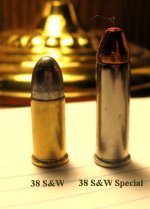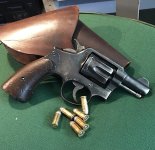actually a 38 special and even a 357 magnum can chamber a 38 smith and wesson cartridge.
two reasons for that.
1. SAAMI upper tolerance limits for the special/magnum chamber are just at the same spec for a sw chamber
2. I dont know if current companies are using correct brass, or just using special brass/38 colt cut to size with a sw head stamp
Interesting post and information. I am not sure about source of information, so I have to experiment for myself. I even tried the old, boiling water freezes faster than room temperature water story that has been told for decades. This is not accurate. With the above thread I decided to try for myself. My dad had a model 36 S&W that he carried for protection. In 35 years, he never fired it. When he gave it to me it was loaded with 38 S&W ammo. When I explained he had the wrong ammo, we decided to shoot it. The gun he carried on many dangerous roads and situations, would not fire. It wasn't the ammo but the gun that would not work. Brand new model 36 would not fire with any ammo. That is another story all together.
So, for this experiment I grabbed my 38 S&W cartridge collection containing 45 different loads from old black powder to British WW2 fmj to modern offerings from Remington and Winchester.
I then grabbed 3 revolvers. A Colt Detective Special, a model 36 S&W both chambered in 38 Special and a S&W model 13 chambered in 357 Magnum. I tried various 38 S&W ammo in each gun and in different chambers of the different guns. The following results were obtained.
In the Colt Detective Special no 38 S&W load would chamber or even get close to chambering.
In the S&W model 36 several loading would completely chamber and the cylinder close. Not all chambers or all loads would but a fair amount would.
In the S&W model 13 chambered in 357, many of the 38 S&W's would chamber quite easily. Only a handful wouldn't. Also noticed that the chambers were note uniform on either S&W revolvers as some chambers would accept certain rounds while others would not. The Colt was adamant about not chambering any and none were close to chambering.
Limited experiment but might be relevant to this conversation.


